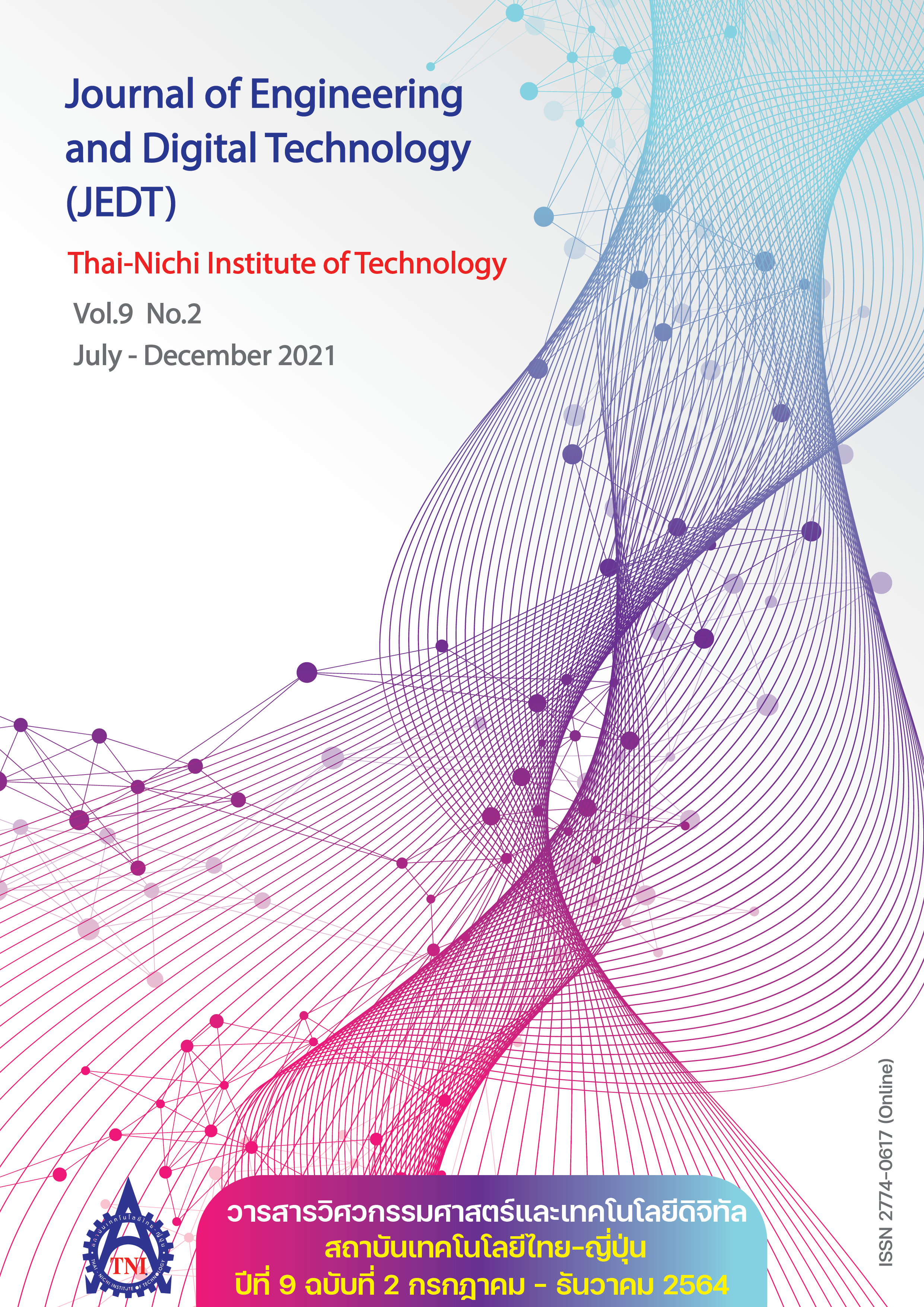A Study of Air Quality Effect by Creating a Device Detect PM2.5, TVOC and CO2-eq
Main Article Content
Abstract
This paper presents the study of air quality effect from particulate matter with diameter of less than 2.5 microns (PM2.5), total volatile organic compound (TVOC) and carbon dioxide equivalent (CO2-eq) for indoor and outdoor Department of Electronics Technology, Ramkhamhaeng University, Bangkok. By creating a device detect air quality for the period from November 2020 to March 2021. From the results, It was found that the average PM2.5 of 24-hour continuous is 31.50 for the inside office (good level), 38.24
for the inside building (moderate level) and 44.80
for the outside building (moderate level). The average TVOC of 8-hour continuous is 0.58
for the inside office (good level), 0.32
for the inside building (good level) and 0.41
for the outside building (good level). The average CO2-eq of 24-hour continuous is 1122.73
for the inside office, 983.97
for the inside building and 922.88
for the outside building.
Article Details

This work is licensed under a Creative Commons Attribution-NonCommercial-NoDerivatives 4.0 International License.
Article Accepting Policy
The editorial board of Thai-Nichi Institute of Technology is pleased to receive articles from lecturers and experts in the fields of engineering and technology written in Thai or English. The academic work submitted for publication must not be published in any other publication before and must not be under consideration of other journal submissions. Therefore, those interested in participating in the dissemination of work and knowledge can submit their article to the editorial board for further submission to the screening committee to consider publishing in the journal. The articles that can be published include solely research articles. Interested persons can prepare their articles by reviewing recommendations for article authors.
Copyright infringement is solely the responsibility of the author(s) of the article. Articles that have been published must be screened and reviewed for quality from qualified experts approved by the editorial board.
The text that appears within each article published in this research journal is a personal opinion of each author, nothing related to Thai-Nichi Institute of Technology, and other faculty members in the institution in any way. Responsibilities and accuracy for the content of each article are owned by each author. If there is any mistake, each author will be responsible for his/her own article(s).
The editorial board reserves the right not to bring any content, views or comments of articles in the Journal of Thai-Nichi Institute of Technology to publish before receiving permission from the authorized author(s) in writing. The published work is the copyright of the Journal of Thai-Nichi Institute of Technology.
References
Ministry of Public Health, Nonthaburi, Thailand. Operation Manual of Medicine and Public Health in Case of PM2.5 in 2020. (in Thai). (2019). Accessed: Dec. 25, 2020. [Online]. Available: http://envocc.ddc.moph.go.th/uploads/downloads/do_manual_PM2.5.pdf
T. Ponpiboon, I. Jayasvasti, and A. Roongpisuthipong, “Disaster in the Winter of Particle Matter (PM2.5),” (in Thai), EAU Heritage J.: Sci. Technol., vol. 8, no. 1, pp. 40–46, Jun. 2014.
Bureau of Environmental Health, Department of Health, Ministry of Natural Resources and Environment, “Effect of VOCs,” in Volatile Organic Compounds: VOCs, Bangkok, Thailand: WVO PRINTING (in Thai), 2012, ch. 2, pp. 7–39. [Online]. Available: https://env.anamai.moph.go.th/web-upload/migrated/files/env/n513_2ab2878f2a72fb61feedcf51190be398_a017.pdf
S. Junsiri, S. Thongdam, W. malakan, and P. Bunna, “The amount of volatile organic compounds (VOCs) in the working area and health conditions of workers in fuel stations: a case study in City Municipality Ubon Ratchathani province,” (in Thai), J. Sci. Technol. Mahasarakham Univ., vol. 36, no. 4, pp. 509–516, Aug. 2017.
W. Jawjit, S. Jawjit, and T. Kulruttanarak, “Life Cycle Greenhouse Gases Emissions of Processed Frozen Chicken,” (in Thai), Thai Sci. Technol. J., vol. 28, no. 9, pp. 1642–1654, Sep. 2020.
Bureau of Environmental Health, Department of Health, Ministry of Natural Resources and Environment, “Carbon Footprint,” in Health Service Center with Carbon Footprint, 3rd ed. Bangkok, Thailand: Rongpimbuddha-press (in Thai), 2014, ch. 3, pp. 18–25. [Online]. Available: http://203.157.71.139/group_sr/allfile/1588988146.pdf
Air Quality and Noise Management Bureau, “Thailand's air quality Information,” Pollution Control Department, Bangkok, Thailand. (in Thai). Accessed: Mar. 31, 2021. [Online]. Available: http://air4thai.pcd.go.th/webV2/aqi_info.php
C. Meyer, Overview of TVOC and Indoor Air Quality. (2021). Accessed: May. 10, 2021. [Online]. Available: https://www.renesas.com/us/en/document/whp/overview-tvoc-and-indoor-air-quality
N. Nuansawan, J. Pinnate, and T. Triwong, “Influence of Air Quality in Green Buildings on Comfortable Conditions,” (in Thai), J. Ind. Technol., vol. 16, no. 2, pp. 55–65, Aug. 2020.
T. K. Boguski, “Understanding Units of Measurement,” Environmental Science and Technology Briefs for Citizens, no 2, pp. 1–2, Oct., 2006. [Online]. Available: https://engg.ksu.edu/CHSR/outreach/resources/docs/2UnitsofMeasure022508.pdf
Plantower Co., Ltd, Shunyi, Beijing, China. PMS3003 series data manual. (2016). [Online]. Available: http://www.plantower.com/en/content/?107.html
T. Zheng et al., “Field evaluation of low-cost particulate matter sensors in high- and low-concentration environments,” Atmos. Meas. Tech., vol. 11, no. 8, pp. 4823–4846, 2018.
O. Phonrit, N. Arnansanti, N. Laotrakulngam, and N. Wattana, “Measuring Dust System in the Air on Smartphone Devices,” (in Thai), J. Inf. Sci. Technol., vol. 10, no. 1, pp. 1–9, Jun. 2020.
G. Yurko et al., “Real-Time Sensor Response Characteristics of 3 Commercial Metal Oxide Sensors for Detection of BTEX and Chlorinated Aliphatic Hydrocarbon Organic Vapors,” Chemosensors, vol. 7, no. 3, Sep. 2019.
Z. Busabong, T. Saenkham, N. Poonsunk, and M. Dechbandid, “Developing an Online Blood Bank Management System with a Blood Bank Temperature Monitoring Device using Internet of Things Technology: a Case Study of Phutthaisong Hospital, Phutthaisong District, Buriram Province,” (in Thai), J. Manage. Rajabhat Maha Sarakham Univ., vol. 7, no. 1, pp. 40–50, Jun. 2020.
T. Muangpool and O. Intharasombat, “Heat Transfer Development using Cooling Copper Tube and Microcontroller,” (in Thai), J. Innov. Technol. Manage. Rajabhat Maha Sarakham Univ., vol. 4, no. 2, pp. 47–56, Dec. 2017.
Air Quality and Noise Management Bureau, “Thailand's air quality and situation reports,” Pollution Control Department, Bangkok, Thailand. (in Thai). Accessed: May. 5, 2021. [Online]. Available: http://air4thai.pcd.go.th/webV2/download_report.php?file=bkk_pm25_2021
Air Quality and Noise Management Division, “Standard of general particulate matter in air of Thailand,” in Manual of Measuring Particulate Matter in Air, Bangkok, Thailand: PCD. MNRE, (in Thai), 2003, ch. 2, sec. 2.2, pp. 4–5. [Online]. Available: http://infofile.pcd.go.th/air/DustinAmbient.pdf


